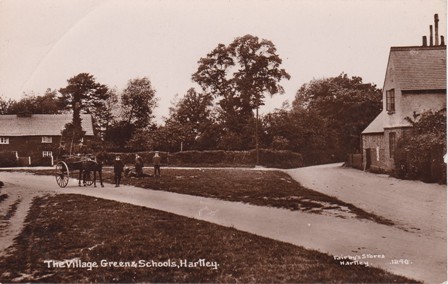Yew Cottage
Yew Cottage in 2015
Although Yew Cottage faces Hartley Cottage across the green, its history is quite different. For one thing, it is a hundred years younger. The manor court roll tells us that Yew Cottage was built by Thomas Young on land that had once been part of Hartley Green, this would date it to Mr Young's ownership of Fairby between 1713 and 1747 - a date consonant with English Heritage's findings. It is constructed of timber and thatch.
Greens were what were known as manorial waste land, that is land not forming part of any landholding. Although they belonged to the lord of the manor, over the years local villagers would have acquired rights of common by local custom, but often only the farms that bordered on a green would have rights to use the land. However they could agree among themselves to enclose the land, which may have happened in this case. Hartley Green is the largest example, but other greens exist at Foxborough (Hartley Court) Green and Stocks Hill/Manor Lane. There also was once another green in the area of the Black Lion, which was enclosed over 300 years ago.
John Young died in 1747, his estate of Fairby and Yew Cottage descended to his daughter Mary, who had married Richard Treadwell. The tradition that Richard and Mary lived here seems unlikely, given that they had Fairby Farm also, but it may be based on the fact other Treadwells lived here, according to the 18th century parish rate book. In 1790 Yew Cottage is not one cottage, but two. Then the tenants were Richard Day and John Treadwell.
The tenants in the 1840s were John Cuckoo, a gunsmith; and John Elcombe, a farm labourer. He had two sons and four daughters. The eldest daughter, Martha, born here in 1845, married a Thomas Henry Yondau and emigrated to Canada. Their descendants are now widely scattered across North America. From about 1855 to his death in 1888, William Elcombe lived here. He was a boot maker and parish clerk for 40 years. I am uncertain whether he is related to the John who lived here previously. Rev Bancks met some of William Elcombe’s children in 1925, on a visit to Hartley when they were in their 60s and 70s. They were able to tell him about Hartley in the mid 19th century.
For many years the Martin family lived in the other half of the house, in 1871 there was James Martin, Naomi his wife and their 9 children. Living conditions must have been very cramped, as then each part of Yew Cottage only had 4 rooms and a scullery
At the turn of the century there was an old walnut tree in front of the cottage on the green. Rev Bancks tells us that the tree blew down after being damaged due to the practice of villagers hanging freshly slaughtered pigs on it and scalding with boiling water (to remove the bristles).

Yew Cottage in first decade of 20th Century
The history of Yew Cottage this century is different too, as it was one of the few properties not to fall into the clutches of Smallowners Ltd. When the Valuation Office visited in 1913 it was owned (with Hartley Green Cottage and Thelcot) by a Mr A W Hall. One of the tenants then was Arthur Blackwell, a foreman platelayer on the Southern Railway. His family continued to live here up to the war. In the other half Edgar and Edith Glidwell lived there for almost 30 years from about 1924. It appears they were just called “Thatched Cottages” before the war.
Now the two halves of Yew Cottage have been united. In 1951 Mr and Mrs Lievesley moved here, and many will remember the Antiques shop that they ran in the left hand cottage. Although Yew Cottage is now surrounded by other houses, it still retains much of its charming character and setting, as well as a very pretty garden.
